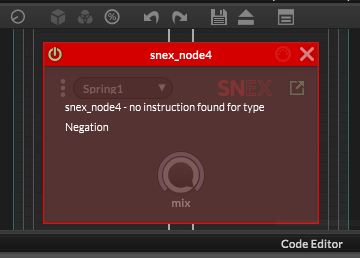What does this snex error mean? (no instruction found for type Negation)
-
I've been seeing this error a lot!

Unfortunately it does not point to any particular line and I cannot figure out what it means!
I've had to abandon a lot of my scripts because I eventually run into this error, and it unfortunately happens when my algorithm becomes longer and more developed.It would be nice just to understand what it means thanks!
There might be other errors in my code but if you want to see it, here it is

template <int NV> struct Spring1 { SNEX_NODE(Spring1); // Note about snex syntax and api. Do not delete empty inliners, variables are declared like (float name = 0.0f;), math functions are used like Math.sin(x) // Start // External Variables float mix = 0.0f; // Internal Variables static const int NUM_CHANNELS = 2; double nyquistFreq = 0.0f; double sr = 0.0f; // Sample rate, initialized here and set properly in the prepare function // Modal parameters using span static const int numModes = 2031; // Number of modes in the audio range span<float, numModes> frequencies; // Resonance frequencies span<float, numModes> damping; // Damping factors span<float, numModes> modalAmplitudes; // Modal amplitudes span<span<float, 2>, numModes> modalStatesL; // State variables for each mode (left channel) span<span<float, 2>, numModes> modalStatesR; // State variables for each mode (right channel) // Function to calculate resonance frequency float calculateResonanceFrequency(int mode, float L, float T, float mu) { return (float)(mode + 1) * ((float)1 / (2 * L)) * Math.sqrt(T / mu); } // Function to calculate damping factor float calculateDampingFactor(int mode, float frequency) { float sigma0 = 3.0f; // Example value from paper float sigma2 = 3e-9f; // Example value from paper return sigma0 + sigma2 * frequency * frequency; } // Function to calculate modal amplitude float calculateModalAmplitude(int mode) { return 1.0f / (mode + 1); // Example: inversely proportional to mode number } // Initialize the processing specs here void prepare(PrepareSpecs ps) { sr = ps.sampleRate; nyquistFreq = sr / 2.0; // Physical properties of the spring float L = 1.0f; // Length of the spring in meters float T = 100.0f; // Tension in Newtons float mu = 0.01f; // Linear mass density in kg/m // Initialize modal parameters for (int i = 0; i < numModes; ++i) { frequencies[i] = calculateResonanceFrequency(i, L, T, mu); // Assign resonance frequencies damping[i] = calculateDampingFactor(i, frequencies[i]); // Assign damping factors modalAmplitudes[i] = calculateModalAmplitude(i); // Assign modal amplitudes modalStatesL[i][0] = 0.0f; modalStatesL[i][1] = 0.0f; modalStatesR[i][0] = 0.0f; modalStatesR[i][1] = 0.0f; } } // Process a block of samples for the left channel void processBlockL(span<float, 1024> block) { for (auto& input : block) { float output = 0.0f; // Update each mode for (int i = 0; i < numModes; ++i) { float freq = frequencies[i]; float damp = damping[i]; float amp = modalAmplitudes[i]; // Modal update equations float y = modalStatesL[i][0]; float yPrev = modalStatesL[i][1]; float yNext = (2.0f * Math.exp(-damp) * Math.cos(2.0f * Math.PI * freq / sr)) * y - Math.exp(-2.0f * damp) * yPrev + amp * input; modalStatesL[i][1] = y; modalStatesL[i][0] = yNext; output += yNext; } // Apply mix input = mix * output + (1.0f - mix) * input; } } // Process a block of samples for the right channel void processBlockR(span<float, 1024> block) { for (auto& input : block) { float output = 0.0f; // Update each mode for (int i = 0; i < numModes; ++i) { float freq = frequencies[i]; float damp = damping[i]; float amp = modalAmplitudes[i]; // Modal update equations float y = modalStatesR[i][0]; float yPrev = modalStatesR[i][1]; float yNext = (2.0f * Math.exp(-damp) * Math.cos(2.0f * Math.PI * freq / sr)) * y - Math.exp(-2.0f * damp) * yPrev + amp * input; modalStatesR[i][1] = y; modalStatesR[i][0] = yNext; output += yNext; } // Apply mix input = mix * output + (1.0f - mix) * input; } } // Process audio samples in blocks (frames) template <int C> void processFrame(span<float, C> data) { if (C > 0) { span<float, 1024> leftChannel = data[0]; processBlockL(leftChannel); // Process the left channel } if (C > 1) { span<float, 1024> rightChannel = data[1]; processBlockR(rightChannel); // Process the right channel } } // Set external variables template <int P> void setParameter(double v) { if (P == 0) mix = (float)(v); } // End // Inliners. Do not delete. Snex won't run without these, they are needed even if empty. // reset Is run every time the software is restarted. You can initialise variable values in here but not declare them void reset(){} // Process the signal as a sample here template <typename T> void process(T& data) {} // Process the MIDI events here void handleHiseEvent(HiseEvent& e){} // Use this function to setup the external data void setExternalData(const ExternalData& d, int index){} }; -
@griffinboy probably this line:
float yNext = (2.0f * Math.exp(-damp) * Math.cos(2.0f * Math.PI * freq / sr)) * y - Math.exp(-2.0f * damp) * yPrev + amp * input;
What happens if you change it to Math.exp(-1.0f * damp)?
I remember stumbling over this too and the SNEX parser chokes at directly negating floating point values
-
Yeah that worked! Thanks!
Edit:
For those who want to know the solution: avoid using the negative of a variable.For example, instead of using (-Variable) use (-1.0f * Variable) instead.